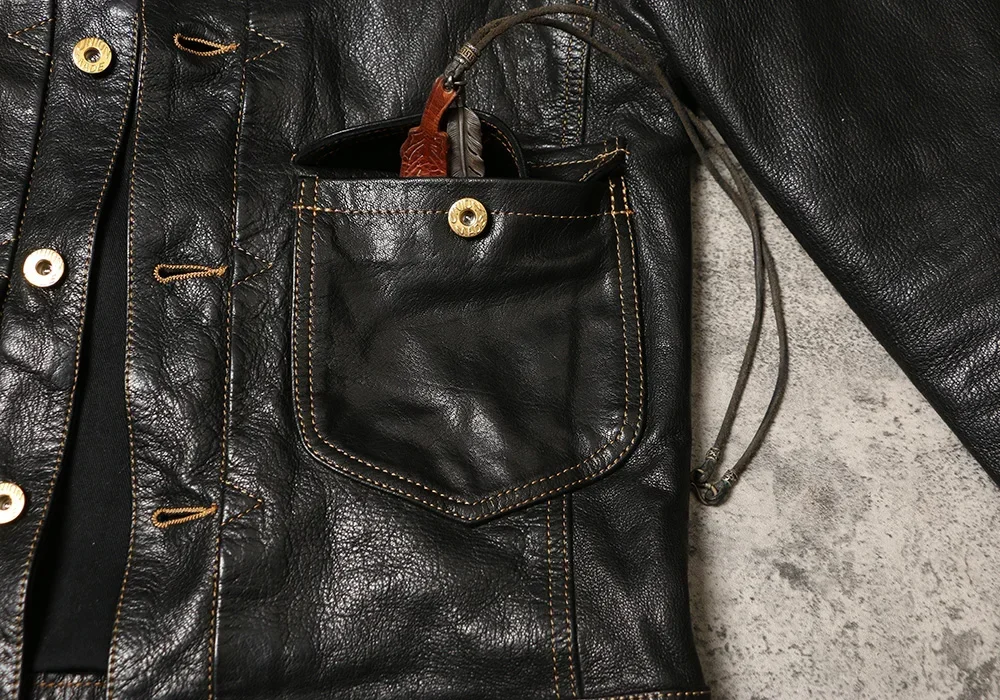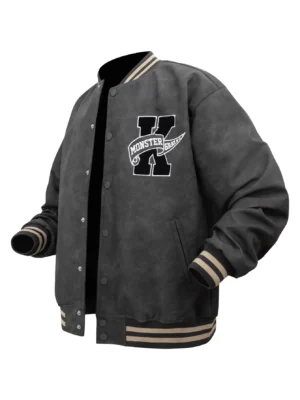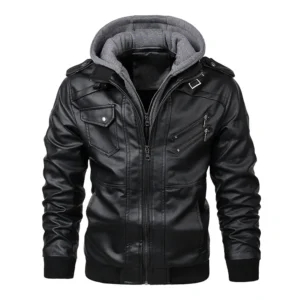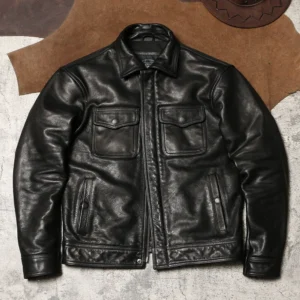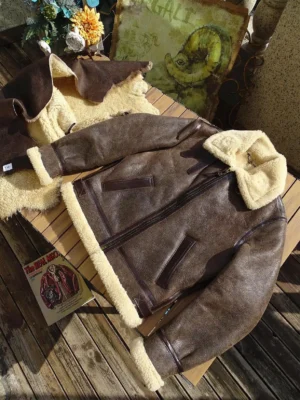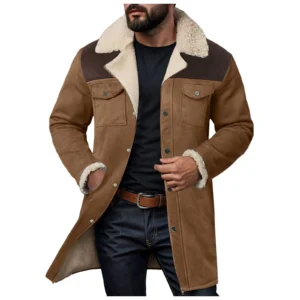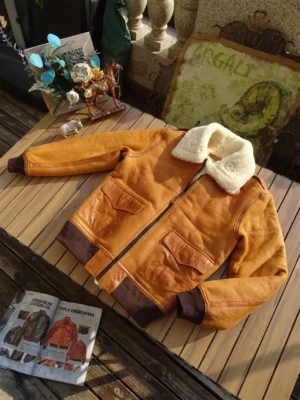1. Introduction: Decoding Your Jacket’s DNA
The leather jacket remains one of fashion’s most enduring icons. From Hollywood rebels to everyday style enthusiasts, these versatile garments have maintained their appeal for generations. But when shopping for a leather jacket, you’ll inevitably face a fundamental choice: genuine leather or faux leather?
Genuine leather is a natural material derived from animal hides (typically cow, but sometimes sheep, goat, or buffalo). It undergoes a tanning process that transforms raw skin into a durable, flexible material with distinctive characteristics. Each piece tells its own story through unique markings, grain patterns, and texture.
In contrast, faux leather (also called synthetic or vegan leather) is manufactured from various non-animal materials. Most commonly, it consists of a fabric base coated with either polyurethane (PU) or polyvinyl chloride (PVC) to simulate leather’s appearance and feel.
Understanding the differences between these options matters for several important reasons:
- Your jacket’s material directly impacts its longevity, comfort, and appearance
- Cost considerations vary significantly between options
- Ethical and environmental priorities may influence your decision
- Each material requires different maintenance approaches
With the global leather goods market valued at over $400 billion, the choices available to consumers have never been more diverse. Both genuine and faux leather have evolved considerably, with improved manufacturing techniques enhancing quality across the spectrum. The guide to men’s black leather jackets provides additional context about how these materials have shaped modern outerwear.
2. At a Glance: Comprehensive Comparison Table
Before diving into detailed explanations, here’s a comprehensive comparison to highlight the key differences between genuine and faux leather jackets:
| Feature | Genuine Leather | Faux Leather |
|---|---|---|
| Material Source | Animal hide (cow, buffalo, sheep, goat) | Synthetic materials (PU or PVC coating on fabric base) |
| Feel & Texture | Soft, supple, warms to body temperature | Typically stiffer, remains cool to touch |
| Appearance & Aging | Develops patina over time, improving appearance | Generally deteriorates with age, may crack or peel |
| Breathability | Naturally porous, allows air circulation | Limited breathability, may cause overheating |
| Durability | 10-20+ years with proper care | 2-5 years on average |
| Price Range | $200-$1,000+ | $50-$200 |
| Maintenance | Regular conditioning, specific cleaning methods | Simple cleaning, no conditioning needed |
| Water Resistance | Naturally water-resistant, needs protection | Often more water-resistant initially |
| Advantages | Durability, comfort, breathability, develops character | Affordable, animal-friendly, wider style options |
| Disadvantages | Higher cost, ethical concerns for some, heavier | Shorter lifespan, less breathable, environmental concerns |
| Environmental Impact | Tanning process can be harmful, but biodegradable | Plastic-based, non-biodegradable, uses fossil fuels |
This table provides a quick reference point as you consider your preferences and priorities. For a closer look at various leather coat options, browse men’s leather and shearling coats to compare styles and materials firsthand.
3. What is Genuine Leather? Understanding the Grades
Not all genuine leather is created equal. The term “genuine leather” actually encompasses several quality grades, each with distinct characteristics:
Full-Grain Leather
The highest quality leather available, full-grain comes from the top layer of the hide and retains its natural grain pattern. It includes all the original texture, markings, and imperfections that tell the story of the animal’s life. This grade offers:
– Maximum durability and longevity
– Development of a beautiful patina over time
– Natural water resistance
– Highest breathability
Top-Grain Leather
The second-highest quality, top-grain leather has been lightly sanded to remove imperfections and then coated with a thin finish. This results in:
– More uniform appearance than full-grain
– Good durability, though slightly less than full-grain
– Greater stain resistance due to the applied finish
– More affordable price point while maintaining quality
Split Leather/Suede
Created from the lower layers of the hide after the top layers are removed:
– Soft, fuzzy texture (in suede)
– Less durable than top or full-grain leather
– More affordable price point
– Often used for the inner portions of jackets
Bonded Leather
The lowest grade, bonded leather consists of leather scraps and fibers mixed with binding agents and applied to a fabric backing:
– Much less durable than other leather types
– Prone to peeling and cracking
– Significantly cheaper than higher grades
– Often misleadingly marketed
It’s important to note that the simple label “genuine leather” often actually indicates lower-grade leather rather than premium quality. When exploring different black leather jacket styles, understanding these distinctions helps you evaluate the quality behind the price tag.
4. Advantages of Genuine Leather Jackets
Genuine leather jackets offer several distinct benefits that explain their premium status and enduring popularity:
Exceptional Durability: A well-made leather jacket can last decades or even be passed down generations. The natural fiber structure of leather creates inherent strength and resistance to tears.
Develops Character Over Time: Unlike most materials that deteriorate with age, quality leather develops a patina—a natural luster and darkening that adds character and uniqueness. This aging process enhances rather than degrades the jacket’s appearance.
Superior Comfort and Breathability: Leather naturally adjusts to your body’s contours over time, creating a custom fit. Its porous structure allows air circulation, preventing overheating and excessive sweating.
Natural Temperature Regulation: Leather provides excellent insulation in cold weather while still allowing enough breathability to prevent overheating, making it suitable for varied conditions.
Timeless Style: Few garments have maintained their fashion relevance like leather jackets. Their classic appeal transcends trends, making them a sound style investment.
Resistance to Elements: With proper treatment, leather effectively resists wind and light moisture, providing practical protection beyond its aesthetic appeal.
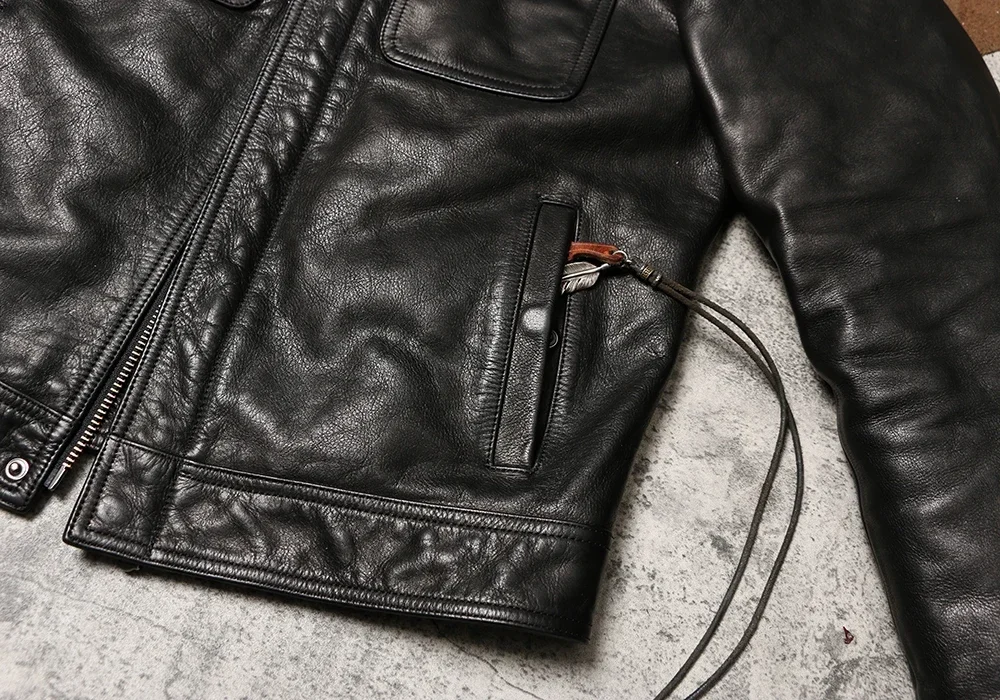
The men’s black leather coat collection showcases examples of quality leather outerwear that embodies these benefits, demonstrating why these jackets remain investment-worthy despite their higher price point.
5. Disadvantages of Genuine Leather Jackets
Despite their many advantages, genuine leather jackets come with several drawbacks worth considering:
Significant Initial Cost: Quality leather jackets typically start around $200 and can easily exceed $1,000, representing a substantial investment compared to synthetic alternatives.
Ethical Concerns: The production of leather requires animal hides, raising animal welfare concerns for many consumers, particularly regarding sourcing practices and the environmental impact of cattle raising.
Environmental Impact of Production: Traditional leather tanning uses chromium and other chemicals that can be harmful to the environment and tannery workers if not properly managed. The process can contribute to water pollution and requires significant resources.
Specialized Maintenance Requirements: Leather needs regular conditioning to prevent drying and cracking, along with careful cleaning using appropriate products. This maintenance regime requires more effort than synthetic materials.
Weight Consideration: Leather jackets are generally heavier than their synthetic counterparts, which might be uncomfortable for some wearers or impractical in certain situations.
Water Vulnerability: Without proper waterproofing treatment, leather can be damaged by heavy rain or snow, potentially causing staining or warping.
For those concerned about maintenance requirements, the definitive guide to protecting your leather jacket provides solutions to help mitigate these care challenges and extend your jacket’s lifespan.
6. What is Faux Leather? Common Types and Their Makeup
Faux leather encompasses several synthetic materials engineered to simulate the look and feel of genuine leather. The most common varieties include:
Polyurethane (PU) Leather
This more modern type of synthetic leather consists of a fabric base covered with a polymer coating:
– More flexible and softer texture than PVC
– Better resemblance to real leather appearance and feel
– More breathable than PVC options
– Created by applying polyurethane coating to a fabric backing
– Generally considered more environmentally friendly than PVC
Polyvinyl Chloride (PVC) Leather
One of the earliest synthetic leathers, also known as vinyl:
– Very durable and resistant to stains
– Less breathable than PU options
– Typically stiffer and less comfortable against skin
– Often has a more obviously artificial appearance
– Less expensive than PU varieties
Emerging Plant-Based Alternatives
Innovative materials are entering the market as sustainable options:
- Piñatex: Made from pineapple leaf fibers, a byproduct of pineapple harvesting
- Mushroom Leather: Created from mycelium, the root structure of mushrooms
- Apple Leather: Derived from apple peels and cores from the juice industry
These newer alternatives aim to address both the ethical concerns of animal leather and the environmental issues associated with plastic-based synthetics.
The manufacturing process for most faux leather involves applying synthetic polymers to a fabric backing, then treating the surface to achieve the desired texture and appearance. When mastering the casual black leather jacket look, understanding these material differences helps you select an option that matches both your style and values.
7. Advantages of Faux Leather Jackets
Faux leather offers several compelling benefits that have contributed to its growing popularity:
Affordability: Perhaps the most obvious advantage is price point, with quality faux leather jackets typically costing between $50-$200, making fashion-forward styles accessible to more consumers.
Ethical Alternative: Synthetic leather eliminates animal welfare concerns, making it the clear choice for vegans and those prioritizing cruelty-free products.
Design Versatility: Without the natural limitations of animal hides, faux leather can be produced in any color, texture, or finish imaginable. This allows for greater experimentation with bold colors and innovative designs.
Low Maintenance: Cleaning is typically straightforward—often just requiring a damp cloth with mild soap. No specialized conditioners or treatments are necessary.
Consistent Appearance: Unlike natural leather that may have variations or “imperfections,” faux leather offers uniformity in color and texture, which some consumers prefer.
Lightweight Comfort: Synthetic options generally weigh less than genuine leather, making them more comfortable for extended wear and travel.
Initial Water Resistance: Many faux leather jackets offer good water resistance without additional treatment, providing immediate protection from light rain.
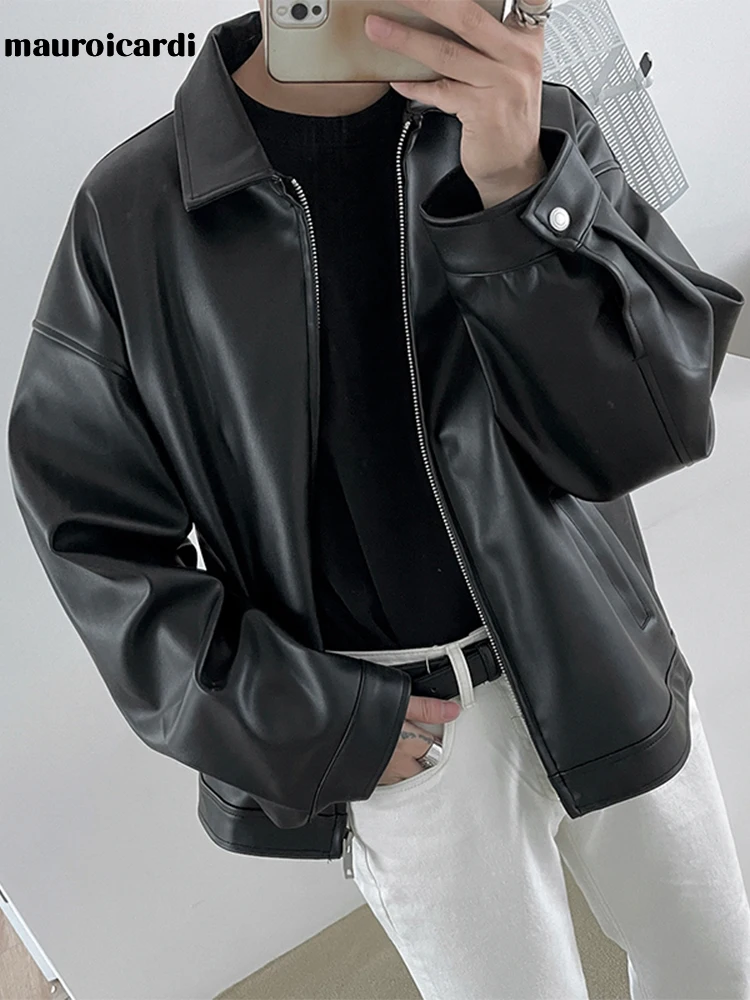
For a better understanding of how these benefits translate into wearable styles, exploring a quality men’s leather coat collection can help you compare options and identify your preferences.
8. Disadvantages of Faux Leather Jackets
Despite their advantages, faux leather jackets come with several significant limitations:
Limited Lifespan: The most notable drawback is durability—synthetic leather typically lasts 2-5 years before showing signs of wear. It often cracks, peels, or tears with regular use.
Poor Breathability: The plastic-based composition restricts air circulation, potentially causing discomfort, overheating, and increased sweating, particularly in warmer weather.
Environmental Concerns: Most faux leather is petroleum-based and non-biodegradable. Production involves chemical processes that release VOCs (volatile organic compounds), and the material can shed microplastics throughout its lifespan.
Aging Characteristics: While genuine leather develops character with age, faux leather generally deteriorates. When it starts breaking down, repair options are limited compared to natural leather.
Chemical Odors: New synthetic jackets often have a distinct chemical smell that can take time to dissipate.
Limited Temperature Regulation: Faux leather doesn’t adjust to environmental conditions as effectively as genuine leather, potentially feeling too hot in warm weather and providing less insulation in cold conditions.
Lower Status Value: While perceptions are changing, synthetic options still typically carry less prestige and perceived value than genuine leather garments.
Understanding these limitations is important when considering long-term value. Proper care can extend a faux leather jacket’s life, and the expert guide to long-term leather coat storage provides valuable information for preserving both genuine and synthetic leather garments.
9. Durability & Longevity: Real-World Expectations
When comparing the lifespan of genuine versus faux leather, the differences are substantial and directly impact long-term value:
Expected Lifespan
- Genuine Leather: With proper care, high-quality leather jackets commonly last 10-20+ years. Many vintage leather jackets from the 1960s and 1970s remain wearable and desirable today.
- Faux Leather: Even well-made synthetic jackets typically show wear after 2-3 years and may need replacement after 3-5 years of regular use.
Common Wear Patterns
- Genuine Leather: Develops creases at flex points, gradually softens, and forms a patina. May experience edge wear or color fading with extensive use.
- Faux Leather: Often begins cracking or peeling at stress points like elbows, cuffs, and collar. Surface coating may wear off, exposing backing material.
Cost Per Wear Analysis
While a $600 genuine leather jacket might seem expensive compared to a $150 faux option, the long-term economics tell a different story:
- Genuine leather at $600 worn for 10 years = approximately $60 per year
- Faux leather at $150 replaced every 3 years = approximately $50 per year
When extended to a 15-20 year period, the genuine leather becomes significantly more economical.
Repair Possibilities
- Genuine Leather: Can be professionally restored, patched, re-dyed, and refurbished. Specialized leather repair services can address tears, stains, and worn areas.
- Faux Leather: Limited repair options once cracking or peeling begins. Patches may not adhere well, and the material generally cannot be restored once deterioration starts.
Understanding these durability factors helps establish realistic expectations and informs your investment decision. For more insights on selecting a durable jacket that meets your needs, the definitive guide to men’s black leather jackets provides additional guidance on quality indicators.
10. Appearance & Texture: Authenticity vs. Uniformity
The visual and tactile differences between genuine and faux leather create distinct aesthetic experiences:
Visual Characteristics
Genuine leather displays natural grain variations, slight color inconsistencies, and small marks or scars that confirm its authentic origin. These “imperfections” contribute to its character and uniqueness. As it ages, leather develops a patina—a soft sheen and slight color deepening that enhances its appearance.
Faux leather offers perfect uniformity with consistent color, texture, and finish throughout the garment. This regularity can appear more pristine initially but lacks the evolving character of genuine leather. Over time, instead of developing character, synthetic materials often fade, crack, or peel in ways that detract from their appearance.
Texture Differences
The tactile experience differs significantly between materials:
Genuine Leather: Feels soft yet substantial, with a supple texture that warms and molds to your body. It has a natural give when touched and compressed, then gradually returns to shape.
Faux Leather: Generally feels more uniform and sometimes stiffer. Higher-quality synthetics have improved dramatically in mimicking leather’s feel, but most still lack the distinctive “hand” (how it feels when touched) of real leather.
Temperature Response
An often-overlooked difference is how each material responds to temperature:
- Genuine leather feels cool initially but quickly warms to body temperature
- Faux leather tends to maintain its temperature and can feel cold against the skin
These appearance and texture differences explain why connoisseurs can often identify genuine leather at a glance or touch—the material possesses subtle qualities that synthetics continue to strive to replicate.
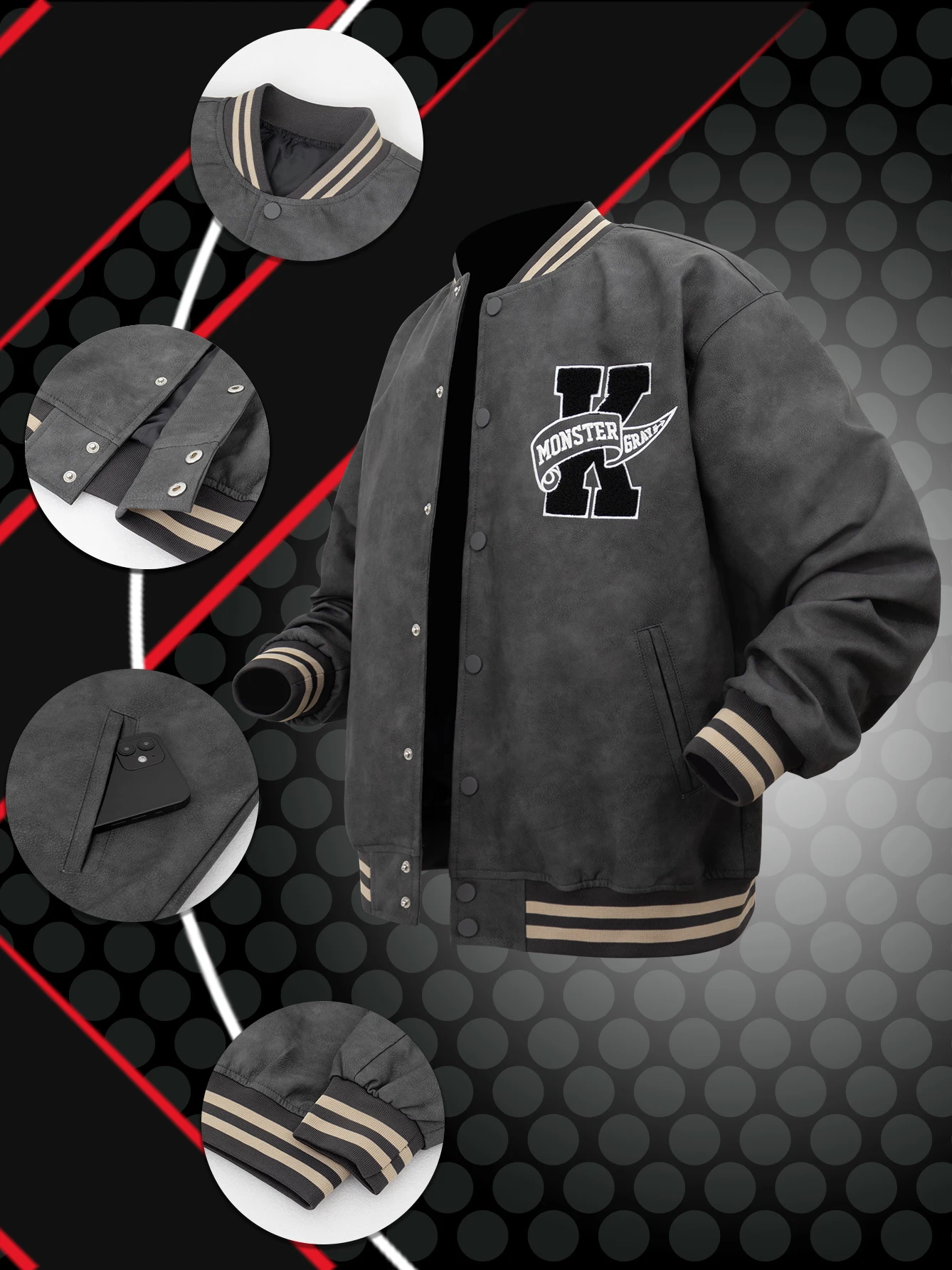
11. How to Identify Genuine Leather from Faux Leather
When shopping for a leather jacket, use these practical techniques to distinguish between genuine and synthetic options:
1. Price Assessment
While not definitive, price provides an initial clue. Genuine leather jackets typically start around $200-$300, with premium options exceeding $500. Jackets priced below $150 are almost always synthetic unless heavily discounted or used.
2. Label Examination
Check for specific terminology:
– Terms like “genuine leather,” “top grain,” or “full grain” indicate real leather
– “PU leather,” “vegan leather,” “synthetic leather,” or “man-made materials” signify faux options
– Be wary of vague terms like “leather finish” or “leather-like material”
3. The Touch Test
Feel the material:
– Genuine leather feels warm, supple, and slightly uneven with natural grain variations
– Faux leather typically feels more uniform, smoother, and slightly plastic-like
– Genuine leather warms quickly to body temperature; synthetic options remain cool
4. Smell Assessment
The scent test is surprisingly reliable:
– Real leather has a distinctive natural aroma often described as rich or earthy
– Synthetic materials may have a chemical or plastic smell, particularly when new or warm
5. Edge and Backing Examination
Check a hidden edge or inside seam:
– Genuine leather reveals a fibrous, suede-like interior at cut edges
– Faux leather shows a fabric backing layer with an obvious coating on top
6. Water Drop Test
In an inconspicuous spot:
– Place a small water droplet on the surface
– Real leather temporarily absorbs water before beading
– Synthetic leather repels water immediately or allows it to sit on the surface
7. Wrinkle and Stretch Test
Gently bunch the material:
– Genuine leather forms natural, irregular creases that remain briefly before slowly returning to form
– Faux leather creates more uniform, sharp creases or may immediately spring back
These identification techniques are particularly valuable when shopping for black leather jackets online, where you can’t physically examine the garment before purchasing.
12. Caring for Your Genuine Leather Jacket
Proper maintenance significantly extends the life of your genuine leather jacket:
Regular Cleaning
- Dust and surface dirt: Wipe with a soft, dry cloth regularly to prevent buildup
- Light soiling: Clean with a slightly damp cloth and mild soap specifically formulated for leather
- Spot cleaning: Address stains immediately using appropriate leather cleaners matched to your leather type
- Professional cleaning: Consider professional leather cleaning annually for heavily worn jackets
Conditioning Essentials
Apply quality leather conditioner every 3-6 months (more frequently in dry climates):
– Use conditioners specifically formulated for garment leather
– Apply sparingly with a soft cloth using circular motions
– Allow to absorb completely before wearing
– Test new products on an inconspicuous area first
Proper Storage Techniques
Between wearings:
– Hang on a padded or wooden hanger to maintain shape
– Allow air circulation (avoid plastic covers)
– Store in a cool, dry environment away from direct sunlight
– If storing long-term, condition before storage and check periodically
Handling Common Issues
- Water exposure: Blot (don’t rub) with an absorbent cloth, then allow to air dry naturally away from direct heat
- Small scratches: Often fixed with gentle finger buffing or small amounts of conditioner
- Deeper scratches: May require leather repair products or professional attention
- Stiffening: Apply leather conditioner to restore suppleness
For more detailed information about specific cleaning products and techniques, consult the comprehensive guide on types of leather cleaners for coats, which provides product recommendations tailored to different leather types.
13. Caring for Your Faux Leather Jacket
While faux leather requires less maintenance than genuine leather, proper care still extends its lifespan:
Effective Cleaning Methods
- Regular maintenance: Wipe with a soft cloth dampened with warm water to remove dust and surface dirt
- Deeper cleaning: Use mild soap diluted in water (avoid harsh detergents)
- Stain removal: Address spots promptly using a gentle circular motion
- Drying technique: Always air dry completely away from direct heat sources
Products to Avoid
Certain substances can damage synthetic leather:
– Alcohol-based cleaners (causes drying and cracking)
– Bleach products (leads to discoloration)
– Oil-based conditioners (creates sticky residue)
– Furniture polish (builds up and damages finish)
Optimal Storage Practices
- Store hanging or flat to prevent creases from becoming permanent
- Avoid folding or compressing for extended periods
- Keep away from direct sunlight to prevent fading and deterioration
- Ensure storage area is dry to prevent mold development
Addressing Common Damage
- Minor peeling: Trim loose pieces carefully with scissors (avoid pulling)
- Small tears: Apply fabric backing with appropriate adhesive
- Cracking: Once significant cracking begins, repair options are limited
- Color restoration: Specific synthetic leather sprays can refresh appearance
Unlike genuine leather, faux leather should not be conditioned with leather products, as these can damage the synthetic coating. Instead, focus on gentle cleaning and proper storage to maximize its lifespan.
Mens Leather Coat, Mens Long Leather Coat
Price range: $225.22 through $235.58 Select options This product has multiple variants. The options may be chosen on the product pageMens Black Leather Coat, Mens Leather Coat
Price range: $181.52 through $197.20 Select options This product has multiple variants. The options may be chosen on the product pageMens Brown Leather Coat, Mens Leather Coat
$846.94 Select options This product has multiple variants. The options may be chosen on the product pageMens Shearling Coat, Mens Sheepskin Coat
$888.08 Select options This product has multiple variants. The options may be chosen on the product page- Price range: $96.28 through $130.88 Select options This product has multiple variants. The options may be chosen on the product page
Mens Shearling Coat, Mens Sheepskin Coat
$2,257.19 Select options This product has multiple variants. The options may be chosen on the product page
14. Environmental & Ethical Considerations: A Deeper Look
The environmental and ethical aspects of leather versus synthetic alternatives present complex considerations:
Animal Welfare Perspectives
Traditional leather production raises legitimate animal welfare concerns. While leather is often positioned as a byproduct of the meat industry, the reality is more complicated:
– Leather quality requirements may influence animal handling practices
– Certain exotic leathers come from animals raised specifically for their hides
– Standards and regulations vary significantly by country of production
Environmental Impact of Leather Production
The environmental footprint of genuine leather includes:
– Land use, water consumption, and methane emissions from cattle raising
– Chemical usage in the tanning process, particularly chromium tanning
– Potential water pollution from improperly managed tannery waste
However, positive developments include:
– Growth in vegetable tanning processes using plant-based materials
– Increased transparency through certification programs
– Leather’s biodegradability at end of life (unlike synthetics)
Environmental Impact of Synthetic Alternatives
Faux leather presents its own environmental challenges:
– Production requires fossil fuel derivatives and significant energy
– Most synthetic leather is non-biodegradable and will remain in landfills
– Microplastic shedding occurs throughout the product lifecycle
– Shorter lifespan means more frequent replacement and waste
Emerging Sustainable Practices
Both industries are developing more sustainable approaches:
– Innovative leather recycling programs
– Improved waste management in tanning processes
– Development of bio-based synthetic alternatives
– Plant-derived leather alternatives with lower environmental impacts
These considerations connect directly to product longevity. Proper maintenance practices, such as those detailed in the guide to preventing leather coat cracks, can extend the useful life of both materials, reducing their overall environmental impact regardless of which you choose.
15. Which Jacket Suits Your Lifestyle? A Decision Guide
Finding the ideal jacket material depends on aligning your priorities with each option’s strengths:
For Budget-Focused Shoppers
- Prioritize faux leather if: Initial cost is your primary concern, you change styles frequently, or you’re uncertain about long-term commitment to a style.
- Consider genuine leather if: You can view it as a long-term investment and value cost-per-wear over initial price.
For Ethically-Motivated Consumers
- Prioritize faux leather if: Animal welfare is non-negotiable or you follow a vegan lifestyle.
- Consider genuine leather if: You prioritize biodegradability, durability, or can source from certified ethical producers.
For Durability-Driven Buyers
- Prioritize genuine leather if: Longevity is paramount or you want a jacket that will develop character over time.
- Consider faux leather if: You anticipate changing sizes or styles within a few years or want variety at lower cost.
For Weather-Specific Needs
- Prioritize genuine leather if: You live in variable climates requiring temperature regulation and breathability.
- Consider faux leather if: You live in rainy environments (better initial water resistance) or very cold conditions where you’ll always wear layers underneath.
For Maintenance Considerations
- Prioritize faux leather if: You prefer minimal care requirements or dislike specialized maintenance routines.
- Consider genuine leather if: You enjoy the care ritual or appreciate how proper maintenance enhances appearance over time.
For Style-Forward Decisions
- Prioritize faux leather if: You value trend exploration, bold colors, or unique textures beyond what’s possible with natural leather.
- Consider genuine leather if: You appreciate classic aesthetics, natural patina development, or heritage styling.
By weighing these factors against your personal priorities, you can make a choice aligned with both your practical needs and core values.
16. Innovations in Leather and Alternatives: What’s Next?
The leather and alternatives industry continues to evolve with exciting developments that may influence future purchasing decisions:
Sustainable Leather Production
Traditional leather manufacturing is embracing sustainability:
– Advanced chrome-free and metal-free tanning processes
– Water recycling systems reducing tannery environmental impact
– Blockchain traceability systems ensuring ethical sourcing
– Vegetable tanning methods using plant-based compounds instead of chemicals
Next-Generation Synthetic Materials
Beyond basic PU and PVC, innovative alternatives include:
– Bio-based polyurethanes utilizing plant oils instead of petroleum
– Recycled plastic-based synthetics repurposing ocean and landfill waste
– Advanced coatings that improve breathability and durability
– Biodegradable synthetic options addressing end-of-life concerns
Revolutionary Plant-Based Materials
Natural alternatives are moving beyond novelty to viable options:
– Mycelium (mushroom) leather scaling to commercial production
– Cactus leather derived from nopal cactus leaves
– Coffee leather using recycled coffee grounds
– Cork-based materials offering natural water resistance
Performance Enhancements
Both genuine and alternative leathers are seeing functional improvements:
– Advanced waterproofing treatments maintaining breathability
– Antimicrobial treatments for reduced maintenance
– Enhanced breathability in synthetic options
– Improved flexibility and comfort in all material types
These innovations point toward a future where the traditional boundaries between natural and synthetic materials may blur, potentially offering the best properties of both worlds: durability and natural aging from genuine leather, combined with ethical production and versatility from alternatives.
17. Is genuine leather always better quality than faux leather?
The assumption that genuine leather automatically indicates superior quality requires nuance. While high-quality genuine leather (particularly full-grain and top-grain) generally outperforms synthetic alternatives in durability and aging characteristics, the “genuine leather” label alone doesn’t guarantee quality.
In fact, lower grades of genuine leather (especially bonded leather) may actually perform worse than premium synthetic options. Bonded leather—made from leather scraps held together with adhesives—often cracks and peels faster than quality faux leather despite carrying the “genuine” distinction.
Quality assessment should consider:
– Specific material grade beyond the basic “genuine” or “faux” designation
– Manufacturing techniques and construction quality
– Intended use and expected performance requirements
For certain applications, high-quality faux leather may be the superior choice. For instance, in high-moisture environments or for specific design aesthetics requiring consistent color and texture, premium synthetics might outperform even good-quality genuine leather.
Rather than assuming natural always equals better, evaluate each jacket on its specific qualities and how well those align with your particular needs and values.
18. Can faux leather ever truly feel like genuine leather?
While synthetic leather technology has improved dramatically, achieving an indistinguishable match to genuine leather remains challenging. Premium faux leather has narrowed the gap considerably, but subtle differences persist that sensitive consumers can detect:
The most difficult genuine leather properties to replicate include:
- Natural temperature response (warming to body heat)
- Distinctive scent profile
- Complex combination of softness with structural integrity
- Natural variations in texture across a single piece
- The way it molds to the body over time
- Aging characteristics and patina development
Today’s highest-quality synthetic options come closest when they:
– Use advanced microfiber bases rather than simple woven fabrics
– Employ multi-layer construction mimicking leather’s structure
– Incorporate variable texturing techniques for less uniform appearance
– Use bio-based components that behave more like natural materials
Rather than focusing solely on perfect imitation, many innovative synthetics now aim to offer their own premium characteristics—such as exceptional lightness, unique textures, or special performance features—rather than merely attempting to mimic genuine leather.
19. Will my faux leather jacket last as long as a genuine leather one?
Direct comparison of longevity between materials shows a significant difference in typical lifespan. Even with optimal care, faux leather generally cannot match genuine leather’s durability:
- Average lifespan of quality genuine leather jacket: 10-20+ years
- Average lifespan of quality faux leather jacket: 2-5 years
Several factors contribute to this disparity:
- Synthetic leather’s surface coating eventually breaks down with repeated flexing
- UV exposure degrades synthetic polymers more rapidly than tanned animal hide
- Repairs to genuine leather are generally more successful and durable
- Genuine leather maintains structural integrity even as it softens with age
However, actual performance depends heavily on:
– Usage frequency and conditions
– Exposure to damaging elements (sun, rain, extreme temperatures)
– Quality of the specific material and construction
– Adherence to proper care routines
For those who update their wardrobe frequently or prioritize ethical considerations over longevity, the shorter lifespan of faux leather may be an acceptable tradeoff given its other benefits.
20. Frequently Asked Questions
Which material is best for cold weather?
Genuine leather typically offers superior insulation in cold weather due to its natural density and fiber structure. It creates an effective wind barrier while still allowing some breathability. For extreme cold, leather jackets with insulation (such as shearling) provide exceptional warmth. Faux leather generally offers less insulation, though lined synthetic jackets can perform well with appropriate inner materials.
Can tears in faux leather be repaired?
Small tears in faux leather can be temporarily repaired using vinyl repair kits or specialized synthetic leather patches. However, these repairs are often visible and may not last long-term. Once faux leather begins tearing, it typically indicates the material is deteriorating more broadly, and repairs become increasingly difficult. By contrast, genuine leather can be professionally repaired with more durable and less noticeable results.
Is waterproofing necessary for genuine leather?
While leather has natural water-resistant properties, additional waterproofing is highly recommended. Without protection, repeated water exposure can lead to staining, warping, and accelerated aging. Apply a quality leather waterproofing product every 3-6 months, focusing particularly on seams and stress points. This maintenance significantly extends your jacket’s lifespan and preserves its appearance.
How do you remove odors from new faux leather?
New faux leather jackets sometimes have a chemical smell that can be unpleasant. To address this:
1. Air the jacket outside in a shaded area for 24-48 hours
2. Wipe down with a solution of equal parts water and white vinegar
3. Allow to dry completely, then apply a fabric freshener designed for synthetic materials
4. If odor persists, place the jacket in a well-ventilated area with activated charcoal or baking soda nearby (not directly on the material)
Does genuine leather stretch over time?
Yes, genuine leather naturally stretches and molds to your body with regular wear. This customization improves comfort and fit over the first few months of ownership. The degree of stretching varies by leather type—softer leathers like lambskin stretch more readily than stiffer varieties like cowhide. Faux leather, by contrast, has minimal stretch capacity and maintains its original dimensions throughout its lifespan.
Are leather jacket styles different between materials?
While many classic styles are available in both genuine and faux leather, certain designs tend to favor specific materials. Traditional motorcycle and aviator jackets often use genuine leather for authenticity and durability. More trend-focused or experimental designs frequently utilize faux leather to achieve unique colors, textures, or details that would be difficult or prohibitively expensive with genuine leather. The material choice should align with both the jacket’s intended style and its expected lifespan.

